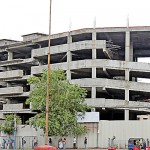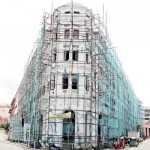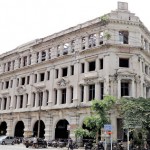News
Colombo ‘haunted’ by too many abandoned, crumbling buildings
View(s):By Ishu Bandara
Colombo is facing a significant challenge due to a large number of abandoned and decaying buildings, the Sunday Times has found.
Officials acknowledge that there is no official count of such structures, and while some fall under government ownership, others are tied up in private disputes, bankrupt companies, or archaeological preservation requirements.
To get to know more about the issue of abandoned buildings that spoil Colombo’s image, the Sunday Times contacted several authorities, including the Urban Development Authority (UDA)and the Colombo Municipal Council (CMC), and finally reached engineer Anuja Mendis, Director of City Planning at the CMC.
“There is no statistical data or database on the exact number of abandoned buildings in Colombo, and the UDA usually does not provide such figures. However, authorities are currently reviewing the Colombo City Master Plan under the ‘Clean Sri Lanka’ initiative, which will address issues related to abandoned buildings,” Mr. Anuja Mendis told the Sunday Times.
- An abandoned building in the Fort area
- A building on Baron Jayathilaka Mawatha that was abandoned for years but is now being developed into a restaurant. Pix by M.A. Pushpa Kumara
- The old Post Office opposite the President’s House looks abandoned but is now used by the Army.
- The Macan Markar building has been abandoned since the COVID period
He further added, “Many of the buildings people identify as abandoned are actually government properties. For instance, the old Post Office opposite the President’s House looks abandoned but is now used by the Army. Some others belong to the Port Authority, the Police, or the Archaeology Department.”
The Sunday Times asked about the building next to the Criminal Investigation Department (CID), known as the Macan Markar building. Although it has archaeological value, it has been left abandoned and spoils the city’s appearance.
The Director of City Planning Mr. Mendis said that abandoned buildings are common across Colombo and include both government and private properties.
Apart from the Macan Markar building and the post office he mentioned the many unused Port Authority buildings along McCallum Road.
Mendis also cited a building on Baron Jayathilaka Mawatha that was abandoned for years but is now being developed into a restaurant by a hotel company after investors were found through multiple Request For Proposal (RFP) calls.
The Sunday Times learned from sources that the four-story Macan Markar building has been abandoned since the COVID period. Valuable items inside were reportedly stolen, and the building was used for illicit activities, including drug-related incidents. Recently, the police temporarily fenced off the entrances with tin sheets, making the area look even more unsightly.
The sources further added, “There’s a rumor that this building once belonged to a former key government official. Before COVID, he sold it to a Saudi citizen who began renovations, but when the pandemic started, he left the country and abandoned the work.”
Signs of the unfinished renovation can still be seen through the broken windows, with the steel bars and interior structures visible from outside.
When the Sunday Times asked about the legal provisions for abandoned buildings that have threatened the city’s appearance for many years, Mr. Mendis highlighted several aspects of the law:
“For private properties identified as unsafe, there are legal provisions under the Municipal Council Ordinance. Authorities can issue a notice to owners to rectify or remove the building. If the owner fails to act, the authorities have the legal right to remove it. This action is usually taken if the building poses a risk to the public, for example, if parts could fall onto the road. A time period of one month, or in some cases as short as seven days, is given for the owner to take action,” he said.
Mr. Mendis also confirmed that while legal provisions exist, challenges remain in their implementation. “There is a system to acquire abandoned government buildings that are difficult to maintain, these buildings are then offered to investors through Requests for Proposals (RFPs) and developed as Public-Private Partnership (PPP) projects.”
As he said, regarding government-owned abandoned buildings, authorities often call for investors through a PPP model. For example, a building on Baron Jayathilake Mawatha required three rounds of RFPs before an investor came forward to begin development, illustrating the difficulty in attracting investors.
Mr. Mendis added that “Many abandoned buildings belong to old companies that went bankrupt or do not have enough funds for redevelopment. the lack of investors and funding obstacles as major challenges in developing these buildings”.
For abandoned Port Authority buildings along McCallum Road, Mr. Mendis noted that while there is a plan to promote tourism and hotels in the area, the buildings remain unused until investors are found.
He explained that funding for redevelopment can come from a mix of government and private investors, with some projects fully supported by the government and others relying on private investment. The main challenge, he said, is ensuring that investors are willing to step forward to develop these properties.
Highlighting the challenges of finding investors, Mr. Mendis said, “Abandoned buildings also exist in areas like Colombo 14 and 15, but they do not receive as much focus compared to prime locations. Buildings in high-value areas such as Pettah, York Street, President’s Mawatha, McCallum Road, and Baron Jayathilake Mawatha are prioritised because it is easier to attract investors for business there. As a result, finding investors for areas like Colombo 14 and 15 remains more challenging.”
As learnt by the Sunday Times, besides the CMC or a UDA related urban planning authority, other institutions involved in abandoned buildings include the Archaeology Department and the government body that owns each building. These groups work together to identify unsafe buildings, take legal action if needed, and plan for redevelopment or preservation.
Mr. Mendis said the Colombo City Master Plan will provide a 10-year framework for growth, and the 2020–2031 plan is under review to address gaps, including abandoned buildings. He added that these neglected structures will soon be transformed into assets supporting tourism, housing, and the city’s global image.
The best way to say that you found the home of your dreams is by finding it on Hitad.lk. We have listings for apartments for sale or rent in Sri Lanka, no matter what locale you're looking for! Whether you live in Colombo, Galle, Kandy, Matara, Jaffna and more - we've got them all!





